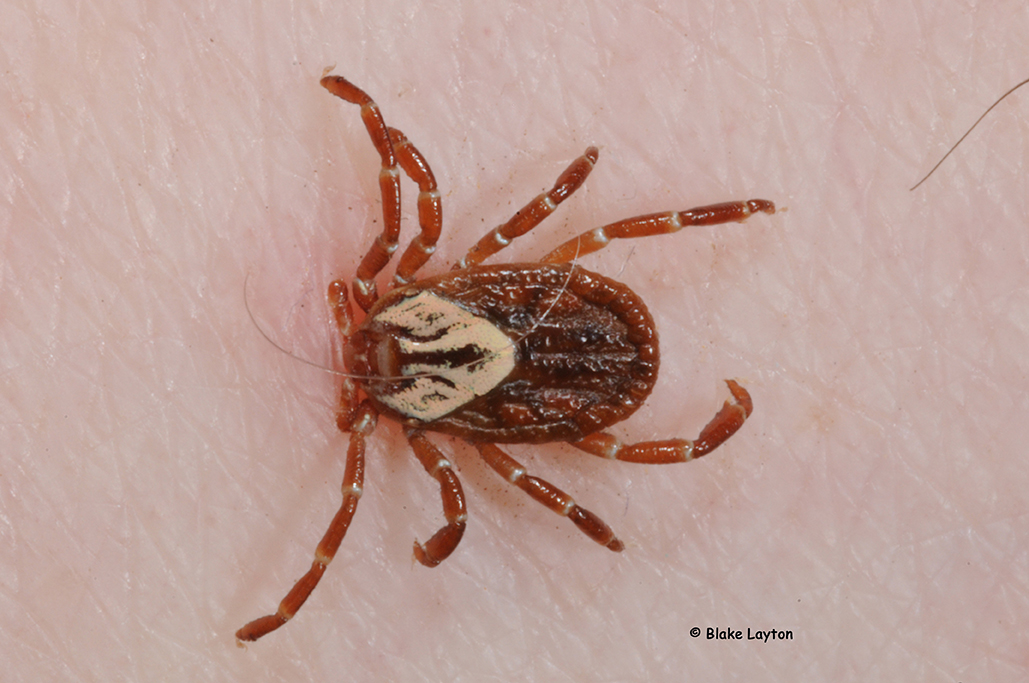Gulf Coast Tick, Vol. 4, No. 16

Amblyomma maculatum
Order: Acari
Family: Ixodidae
Makes you itch just to look it; doesn’t it? Gulf Coast ticks arguably have the most irritating bite of any tick. In fact, their bites can cause permanent deformities to ears of grazing animals such as cattle and goats, a condition known as “gotched ear”. Gulf Coast Ticks occur throughout the state and as far north as southern Missouri. Here in Mississippi they are most often encountered late spring through fall, with adults being most common in July and August. Gulf Coast ticks vector Rickettsia parkeri, which can cause an area of dead, blackened tissue at the site of a bite and a mild form of Rocky Mountain Spotted Fever.
These are three-host ticks, which means that each life stage feeds on a different host. Newly hatched, six-legged larvae usually start out feeding on a bird or small mammal and drop to the ground when full of blood to molt. The resulting nymphs find another bird or small mammal to feed on and then drop to the ground and molt into adults. Adults prefer larger mammals, such as cattle, deer, dogs, or people. Mating occurs on the host before engorged females drop to the ground to lay their eggs.
Control: The best way to avoid ticks is to stay out of the woods and weeds and on the beaten path. Think about where the animals ticks feed on spend most of their time and try to avoid such places, especially when not properly prepared. Take appropriate precautions when entering “ticky” areas. Wear high-topped boots with pants legs tucked inside, and shirttail tucked into pants. Use DEET-based repellents to protect exposed skin and use permethrin-based repellents to treat clothing and shoes that will be worn into “ticky” areas, but do not apply permethrin products directly to skin! Shower and check for ticks as soon as possible, and promptly remove any ticks found. Those clothes you were wearing may still have ticks on them. Wash them in hot, soapy water immediately to avoid having hungry ticks wandering around the house.
Minimize tick infestations in home landscapes by keeping grass mown and maintaining weed-free walking trails through wooded areas. Fence yards to keep out large feral mammals, and regularly treat pets with effective tick prevention treatments. This last point is especially important for folks who live in rural settings and have free-roaming dogs or cats. They go roaming in the woods and weeds, accumulating ticks and bringing them back when they return home. To control ticks in home landscapes use broadcast sprays containing active ingredients such as bifenthrin or permethrin. Use sprays, not granules, because granules will drop to the ground below the area where questing ticks are waiting. See page 16 of Extension Publication 2331, Control Insect Pests in and Around the Home Lawn for more information.
Thanks to Dr. Jerome Goddard, Extension Medical and Veterinary Entomologist, for his assistance and input in preparing this article.
Blake Layton, Extension Entomology Specialist, Mississippi State University Extension Service.
The information given here is for educational purposes only. Always read and follow current label directions. Specific commercial products are mentioned as examples only and reference to specific products or trade names is made with the understanding that no discrimination is intended to other products that may also be suitable and appropriately labeled.

